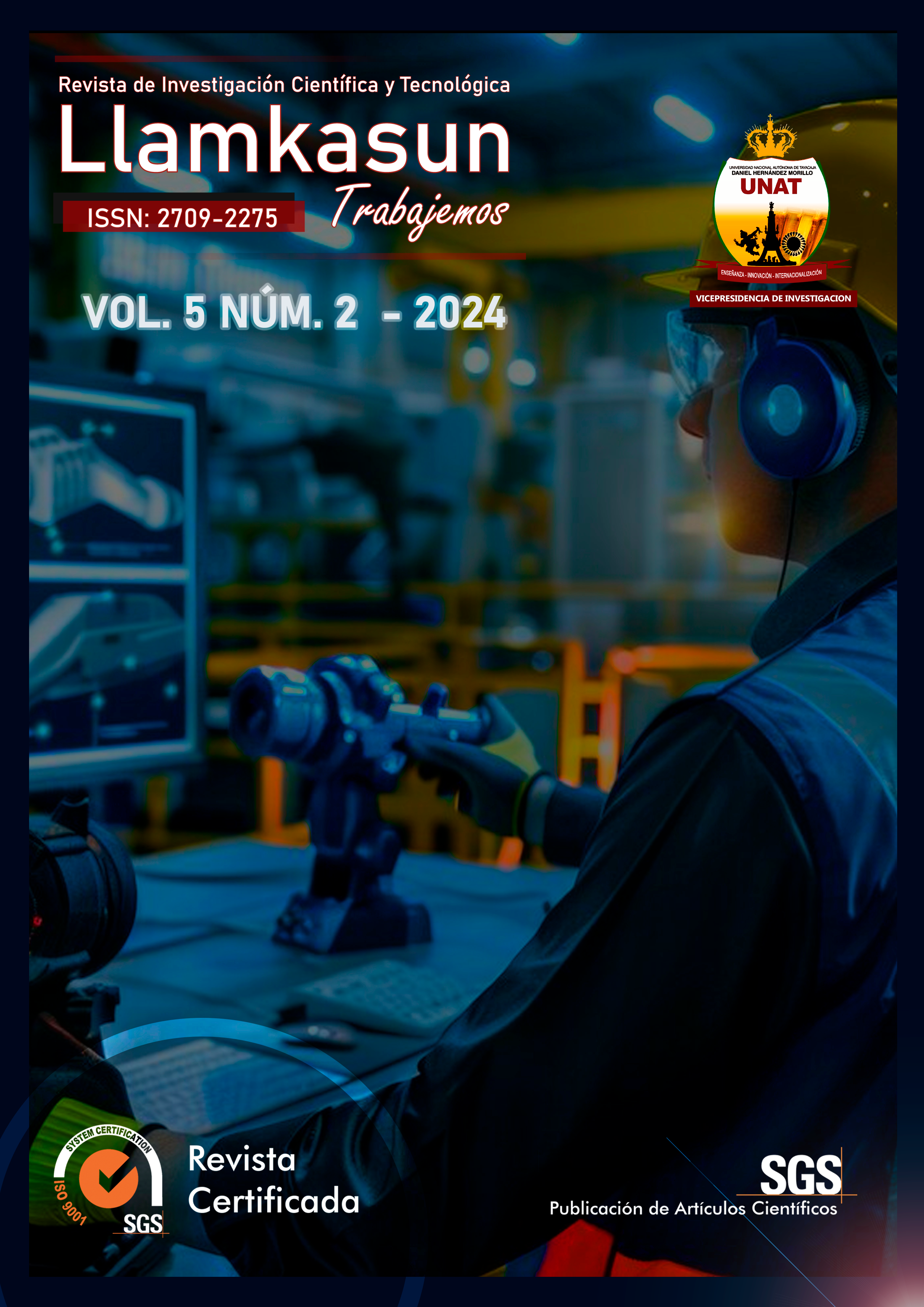Abstract
This study, titled "Structural Vulnerability to Seismic Hazards in Housing in Zone X of Huaycán, Ate-Vitarte District, 2023," provides an in-depth evaluation of the seismic vulnerability of self-constructed housing within a highly seismic region of Lima. The methodology encompasses a comprehensive assessment of 2-, 4-, and 6-story residential buildings using compressive strength testing of concrete, which revealed a 30% deficiency relative to the E030 standard. To quantify collapse probabilities, advanced dynamic simulations and nonlinear analyses, including Incremental Dynamic Analysis (IDA), were conducted. The results indicate that 2- and 4-story structures are particularly susceptible, with an estimated collapse rate of 20.5% under extreme seismic conditions. Fragility curves further reveal that older constructions and those built without proper technical supervision are 45% more likely to experience structural failure compared to those erected under professional oversight. This underscores an urgent need for retrofitting interventions. Additionally, the study introduces a seismic resilience index aimed at quantifying the capacity of self-built housing to endure seismic events, providing a continuous assessment tool that supports enhanced construction practices and promotes the safety of vulnerable communities.
References
Ahmad, N., Ibrahim, A., & Alam, S. (2019). Analytical Seismic Fragility Curves for Reinforced Concrete Wall pier using Shape Memory Alloys considering maximum drift. MATEC Web of Conferences, 258, 04001. https://doi.org/10.1051/matecconf/201925804001
Alberto Maturana, P. (2011). Risk assessment and disaster management. 10 questions for the current decade. Revista Médica Clínica Las Condes, 22(5), 545–555. https://doi.org/10.1016/s0716-8640(11)70465-5
Allen, D. E., & Rainer, J. H. (1995). Guidelines for the seismic evaluation of existing buildings. Canadian Journal of Civil Engineering, 22(3), 500–505. https://doi.org/10.1139/l95-058
AmiriHormozaki, E., Pekcan, G., & Itani, A. (2015). Analytical fragility functions for horizontally curved steel I-girder highway bridges. Earthquake Spectra, 31(4), 2235–2254. https://doi.org/10.1193/022213EQS049M
Aroquipa, H. (2022). Resilience of structural systems to seismic events assessed using PML and PAE [Universidad Nacional Federico Villarreal]. https://hdl.handle.net/20.500.13084/6147
Aroquipa, H. (2024). Seismic resistance in structural systems: Analysis using PML and PAE (1st ed.). UNAT Editorial Fund. https://doi.org/https://doi.org/10.56224/ediunat.55
Aroquipa, H., & Hurtado, A. (2022a). Seismic resilience assessment of buildings: A simplified methodological approach through conventional seismic risk assessment. International Journal of Disaster Risk Reduction, 77(February), 103047. https://doi.org/10.1016/j.ijdrr.2022.103047
Aroquipa, H., Hurtado, A., Angel, C., Aroquipa, A., Gamarra, A., & Almeida Del Savio, A. (2023). A cost-benefit analysis for the appraisal of social and market prices in the probabilistic seismic risk assessment of building portfolios: A methodology for the evaluation of disaster risk reduction programs. International Journal of Disaster Risk Reduction, 90(October 2022), 103637. https://doi.org/10.1016/j.ijdrr.2023.103637
Aroquipa, H., Hurtado, A., Heredia, R., Si-Qi, L., & Angel, C. (2024). Seismic Hazard Assessment Based on Predominance of Local Earthquake Sources: A Methodological Approach Using Psha Applied to the Main Cities in Peru. Available at SSRN 4766956.
Aroquipa, H., & Hurtado, A. I. (2022b). Incremental seismic retrofitting for essential facilities using performance objectives: A case study of the 780-PRE school buildings in Peru. Journal of Building Engineering, 62, 105387. https://doi.org/10.1016/j.jobe.2022.105387
Aroquipa, H., Yamín, L. E., Reyes, J. C., & Rincón, J. R. (2016). Evaluation of the seismic vulnerability of reinforced concrete buildings using simplified nonlinear dynamic analysis LK - https://univdelosandes.on.worldcat.org/oclc/1027979102 [Uniandes]. https://biblioteca.uniandes.edu.co/acepto201699.php?id=11197.pdf.bk
Batabyal, A. A. (1998). The concept of resilience: retrospect and prospect. Environment and Development Economics, 3(2), 235–239.
Becerra, R. (2015). Seismic risk of buildings in the Horacio Zevallos urbanization of Cajamarca-2015. (Undergraduate Thesis), 1–92. http://repositorio.upn.edu.pe/handle/11537/7329
Belejo, A., & Bento, R. (2016). Improved Modal Pushover Analysis in seismic assessment of asymmetric plan buildings under the influence of one and two horizontal components of ground motions. Soil Dynamics and Earthquake Engineering, 87, 1–15. https://doi.org/10.1016/j.soildyn.2016.04.011
Bruneau, M., Chang, S. E., Eguchi, R. T., Lee, G. C., O Rourke, T. D., Reinhorn, A. M., Shinozuka, M., Tierney, K., Wallace, W. A., & Von Winterfeldt, D. (2003). A Framework to Quantitatively Assess and Enhance the Seismic Resilience of Communities. In Earthquake Spectra (Vol. 19, Issue 4, pp. 733–752). https://doi.org/10.1193/1.1623497
Bruneau, M., & Reinhorn, A. (2007). Exploring the concept of seismic resilience for acute care facilities. Earthquake Spectra, 23(1), 41–62.
Cheung, M., Foo, S., & Granadino, J. (2000). Seismic retrofit of existing buildings: innovative alternatives. Public Works and Government…, 1–10. http://www.ironwarrior.org/ARE/Lateral_Forces/Cheung-M Seismic Retrofits.pdf
Cimellaro, G. P., Reinhorn, A. M., & Bruneau, M. (2010). Seismic resilience of a hospital system. Structure and Infrastructure Engineering, 6(1–2), 127–144. https://doi.org/10.1080/15732470802663847
Colapietro, D., Netti, A., Fiore, A., Fatiguso, F., & Marano, G. C. (2014). interventions in r. c. buildings by non-linear static and incremental dynamic analyses. 8(January 2014), 216–222.
Covarrubias, A. P., & Raju, E. (2020). The politics of disaster risk governance and neo-extractivism in Latin America. Politics and Governance, 8(4), 220–231. https://doi.org/10.17645/pag.v8i4.3147
FEMA. (2009). Multihazard Loss Estimation Methodology Earthquake Model HAZUS. Federal Emergency Management Agency, 718.
Firmansyah, H. R., Sarli, P. W., Twinanda, A. P., Santoso, D., & Imran, I. (2024). Building typology classification using convolutional neural networks utilizing multiple

This work is licensed under a Creative Commons Attribution 4.0 International License.
Copyright (c) 2024 Cesar Arriola Prieto






